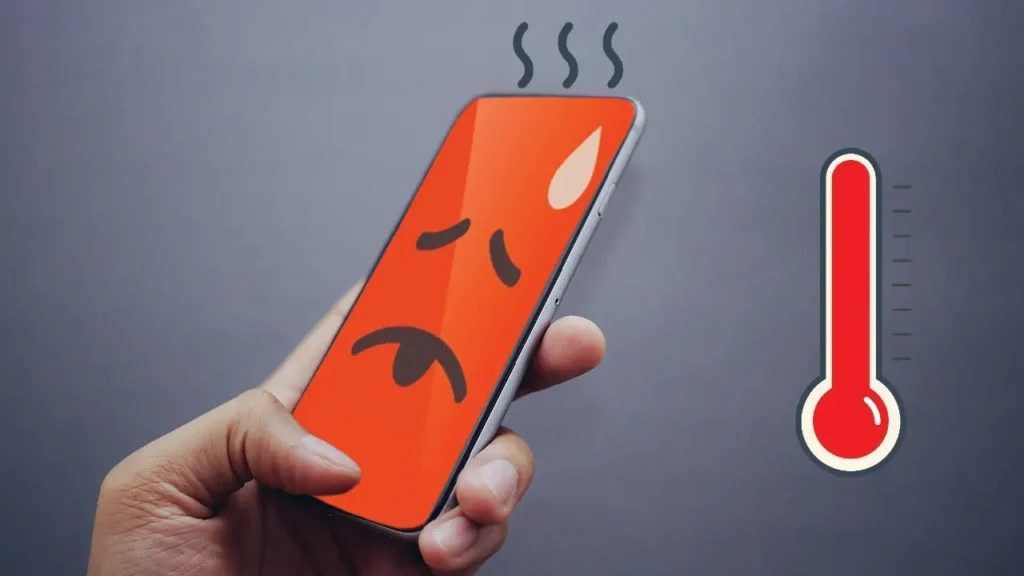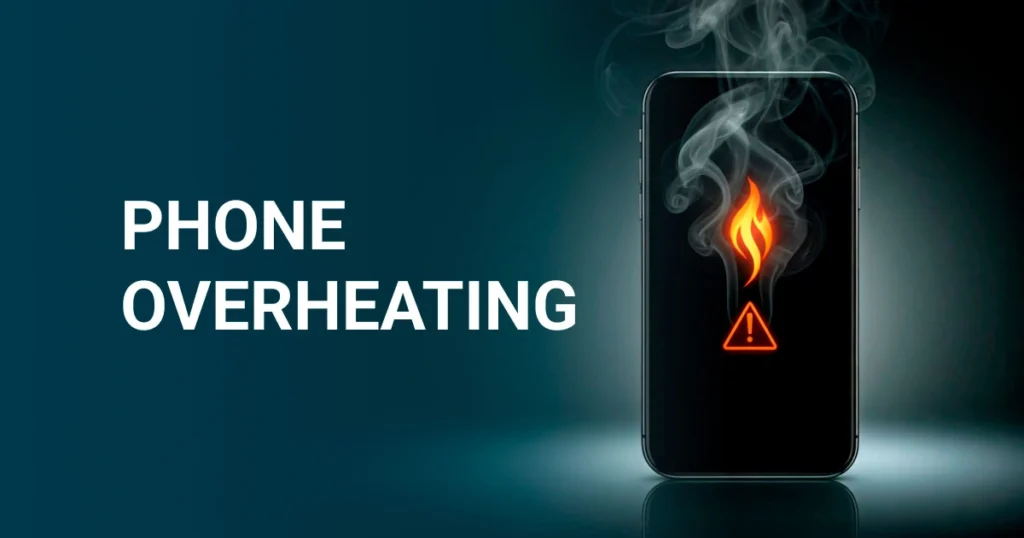Is your phone overheating? Are you worried?
Smartphones are the cameras we use, the navigators, our entertainment center, and the window to the world. However, like any complex tool, they are not without their idiosyncrasies. Among the numerous problems that users encounter, the most frequent is the device overheating.
Such a transition from uncomfortable warmth to dangerous heat can be rather worrying, to say the least of the harm done to the device.
It is important to know what causes phone overheating and how to deal with phone overheating to avoid damaging it.

Understanding the Culprits: Why Your Phone Overheats
However, as we discuss solutions, it is crucial to understand why your phone gets hotter than usual and what possible causes are at play. Here are some of the most common culprits:
1. Intensive Processing:
- Gaming: You also get to use more of your phone’s processor and graphics chip when playing graphically intensive games. This kind of work load produces a lot of heat.
- Resource-Hungry Apps: When you run many heavy applications at once, you load the phone’s processor, for instance, when you are using an application such as video editing software or even a complex spreadsheet.
- Prolonged Usage: Apparently, simple activities such as watching videos or spending hours on social media can cause overheating because the processor is constantly working.
Explore A Comprehensive Guide to Cleaning Your Laptop and Preventing Overheating
2. Charging Issues:
- Fast Charging: As much as fast charging is effective, it produces more heat than normal charging processes in a car. This is especially the case if the environment is already warm.
- Faulty Chargers or Cables: Chargers or cables that are not recommended by your phone manufacturer or have faulty parts create an irregular charge that increases heat production.
- Charging in Hot Environments: Charging your phone under direct sunlight or placing it in a hot car is almost certain to cause phone overheating problems.
3. Ambient temperatures:
- Direct Sunlight: If you leave your phone in the open with direct sunlight on it, especially during a hot day, then you will find your phone overheating quickly.
- Hot Cars: The temperature inside a parked car can rise to a high level, making it an oven for your device.
- Humid Climates: High temperatures and high relative humidity slow down the rate at which the phone can shed heat.
4. Battery Problems:
- Aging Battery: Over time, phone batteries degrade, take longer to charge fully, and become less efficient, producing more heat during charging and use.
- Damaged Battery: Even a physically damaged battery, maybe from a drop or exposure to extreme temperatures, can likely cause the battery to overheat and have safety concerns.
5. Software Glitches and Malware:
- Software Bugs: Various problems in the operating system or certain applications can make the phone’s processor work more intensively than it should, thus heating up.
- Malware Infections: Certain malware can have background operations that constantly use up many computing resources and may cause a system to get hot.
6. Poor ventilation:
- Bulky Cases: Non-portable, that is, thick, covers for the phones may hinder heat from being released from the phones.
- Covered Vents: There are phone designs with vents for air release to ease heat; putting your hand or other objects on the vents will only make it worse.
The Effects of Phone Overheating
It is not just about being unable to handle a hot phone; that is where the problem lies. Prolonged or repeated overheating can have several detrimental effects:
- Performance Throttling: To avoid damaging the hardware, the operating system of the phone might decrease the speed of the processor, and this causes lagging.
- Battery Degradation: This is especially true with heat since it is one of the biggest foes of batteries. Excessive use of battery charges may lead to quicker development of battery problems and require charging much more often.
- Hardware Damage: High temperatures may be detrimental to the device’s internal parts, for instance, the processor, display or memory chips.
- Safety Concerns: In the worst-case scenario, an overcharged battery may swell and crack or even catch fire. It is, however, rather rare, but it is a severe safety concern that cannot be overlooked.
How To Fix Overheating Phone: Practical Solutions
Now that we understand the potential causes, let’s explore practical ways to fix an overheating phone and prevent future occurrences:
1. Immediate cooling actions:
- Power Down: The easiest and quite often the most helpful one is to switch the phone off and let it rest for a while. This gives all the components a break.
- Remove the Case: Remove any thick or non-ventilated phone cases to help the heat spread away from the phone easily.
- Move to a Cool Environment: Take your phone away from the heat and place it in a cool, shaded area.
2. Manage Apps and Usage:
- Close Unused Apps: Turn off all other applications that are still open, even if they are not in use at the moment. But don’t simply switch between them; close them all at some point.
- Limit Background App Refresh: Some apps do not require background refresh, and so it should be turned off. This minimizes other unrelated processes in the background.
- Lower Screen Brightness: A bright screen draws a lot of current and has the additional problem of heat. Dim down the light to a comfortable level.
- Turn Off Unnecessary Features: Switch off such options as Bluetooth, WI-FI, or GPS when you don’t need them because they use power and produce heat.
- Limit Gaming and Resource-Intensive Tasks: Limit the time spent on graphic-sensitive games or applications that consume much of the device’s resources. Perhaps one should apply it in smaller portions with intersession rest.
3. Charging Best Practices:
- Use certified chargers and cables: Only use the charger and cable that came with the phone or an original accessory from a manufacturer’s authorized dealer.
- Avoid Fast Charging When Not Needed: If time is not crucial, do the normal charging to minimize the heat produced.
- Charge in Cool Environments: Do not place your phone’s charging cable under direct sunlight or charge your phone in a hot environment.
- Don’t Charge Overnight: Unlike modern phones, these phones do not allow one to charge the phone all night and expect it to turn off when charged fully. It is advisable not to charge the phone all night.
- Consider Wireless Charging Alternatives: Wireless charging may somewhat produce less heat if the phone supports it, however, it still takes care of the environment it is placed in.
4. Software and Updates:
- Keep Your Software Updated: Make sure your phone’s operating system and all your applications are up-to-date. Software updates contain features that can help prevent or even eliminate phone overheating problems.
- Check for Malware: The above could be triggered by malware running in the background, which pulls the CPU temperature up, hence overheating the device; use an appropriate antivirus app to scan the device.
- Clear App Cache: Removing the cache of such applications can help at times and may also help to prevent overheating in some cases.
5. Battery Care and Maintenance:
- Monitor Battery Health: The battery health settings of your phone should be checked (if any are available). If the battery shows signs of considerable degradation, it may be time to go and get a new one.
- Avoid Extreme Temperatures: Do not drop your phone passwords, as they weaken the battery, especially when exposed to heat or cold environments.
- Consider Battery Replacement: If your battery has become old or is showing signs of wear, then it is advisable to have the battery replaced by a professional.
6. Ventilation and Phone Case Considerations:
- Choose Breathable Cases: Choose phone cases that have these materials to make the cell phone have better airflow and heat dissipation.
- Avoid Covering Vents: Understanding the ventilation design of your phone and ensuring that you do not put hands or any other thing on the vent.
Learn How to Fix Slow Internet at Home
When to Seek Professional Help
In case none of the above steps help to solve the problem of your phone overheating, or if you think that the problem is rooted in the hardware, you should turn to a professional. Go to the manufacturer of the phone and seek assistance, or take your phone to any recognized service center. If the problem is not addressed over time, it will result in more serious problems and expensive repairs.
Conclusion: The Key Takeaway About Phone Overheating
Phone overheating is a common issue, but it is often due to usage factors, environmental factors, and possible hardware defects. It is thus important not only to understand the causes of the phenomenon of overheating phones and to use the correct methods to solve it, not only to avoid discomfort but also to increase the durability of the device.
This means that you need to be careful with your phone while it’s charging, keep your software updated, and you will be able to minimize how to fix overheating phones and enjoy your device for many years.
Prevention is always better than cure; do not wait for your phone to heat up; it is best to act immediately.




